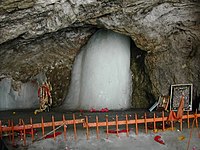Pilgrimage
It is a popular pilgrimage destination for Hindus - about 400,000 people[6][not in citation given] visit during the 45-day season around the festival of Shravani Mela in July–August, coinciding with the Hindu holy month of Shraavana.Devotees generally take the 42 km (26 mi) pilgrimage on foot from the town of Pahalgam, about 96 km (60 mi) from Srinagar, and cover the journey in four to five days. There are two alternate routes to the temple: the longer and more traditional path from Srinagar, and the shorter route from the town of Baltal. Some devotees, particularly the elderly, also ride on horse-back to make the journey. Those who so wish and have the money can now make the journey by helicopter.[7]
[edit] 1990s Problems
The pilgrimage was banned from 1991 to 1995 due to threats from militants. In 1996 the militants had assured that they would not interfere allowing a resumed yatra with far greater numbers than in previous years. However, unseasonal blizzards in late August of that year caught up to a hundred thousand pilgrims by surprise in a tragedy that claimed the lives of 242 yatris, killed by exhaustion and exposure.[8][9][edit] 2000 Massacre
Four years later, the pilgrimage suffered another setback with the massacre in Pahalgam of 30 people by Kashmiri separatist militants.[10] Most were yatris on their way to Amarnath [11] or porters and horsemen who would have ferried the pilgrims to the site.[12] Then Indian Prime Minister Atal Bihari Vajpayee blamed Lashkar-e-Taiba for the killings.[13][edit] 2007 melting controversy
Shree Amarnathji Shrine Board (SASB) former chief executive officer Arun Kumar was reported in The Hindu as saying "The Shivlingam has melted owing to the rise in temperatures. It is a normal phenomenon; weather affects its shape and size".[14] The other ice lingams had not completely melted. Many environmentalists blamed global warming for the incident.[15] The SASB has authorized the installation of a cooling system to preserve the formations in coming years.[16][edit] 2008 Land transfer controversy
See also: Amarnath land transfer controversy
On 26 May 2008, the Government of India and the state government of Jammu and Kashmir reached an agreement to transfer 100 acres (0.40 km2) of forest land to the Shri Amarnathji Shrine Board (SASB)[17] to set up temporary shelters and facilities for Hindu pilgrims. Kashmiri separatists opposed the move citing reasons that it will jeopardize the article 370 that gives separate identity to the people of Jammu and Kashmir and prevents any Indian citizen to settle in Kashmir. People in Kashmir staged widespread protests against this decision by government of India.[18] Due to the protests, the J&K State government relented and reversed the decision to transfer land. As a result, Hindus in the Jammu region launched counter-agitations against this roll back
No comments:
Post a Comment